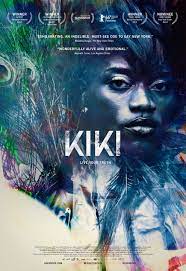
KIKI
US, 2016, 94 minutes, Colour.
Twiggy Pucci Garcon.
Directed by Sara Jordeno.
Drawing on the Wikipedia article on Kiki.
Kiki is an American-Swedish co-produced documentary film, released in 2016. It takes place in New York City, and focuses on the "drag and voguing scene (deriving from Madonna and her song Vogue ("Voguing"—an exaggerated dance style started in the underground ballroom scene in Harlem) surveying the lives of LGBT youth of color at a time when Black Lives Matter and trans rights are making front-page headlines".The film was directed by Sara Jordenö and considered an unofficial sequel to the influential 1990 film Paris Is Burning,]the film profiles several young LGBT people of colour participating in contemporary LGBT African American ball culture.
Jordenö was invited to create the film by Twiggy Pucci Garçon, a leader in the kiki community in New York. She cowrote the film with them. Jordenö was able to film her subjects over the course of several years. She was able to follow two of the film's subjects Gia Marie Love and Izana Vidal as they went through their own transitions as trans women.
The drag and ball scene are venues in which many queer and transgender people of color can find community as well as express themselves. Kiki is more intertwined with activism and education as it focuses more on people between the ages of 13 and 24 instead of older queer and transgender individuals.
“While there are similarities in many of their stories, each journey is different. Many of the young adults profiled have been kicked out of the house for being trans, queer, or just gender-nonconforming. They have gravitated towards one another, and immersed themselves in a culture that is nonjudgmental, open, and caring. They take care of each other. They crash on each other's couches. They have each other's collective backs.” Sheila O’Malley, Rogerebert reviews.)
The issues that transgender youth of color face include the struggle that many transgender people of color faced was trying to start and continue their hormone replacement therapy as well as sex work.
Kiki also depicts what it is like for LGBT youth of color to experience discrimination. When it comes to the LGBT neighborhoods, there is some mention of police officers that patrol the neighborhood engaging in homophobia. As a result of the discrimination that they face from society, many have to navigate taking part in sex work as a means to support themselves.
This is also where the ballroom and drag scenes come into play as many of these youths use these avenues to claim space that otherwise would be denied to them. Kiki is a film that is glamorous, but also educates its audience and depicts the very serious realities that many LGBT youth face.
HIV/AIDS activism is so important to them and the kiki scene. There is a strong focus on community education within the film to help show the youth that this tight knit community cares for them and wants to keep them safe. The film discusses how education and activism can be difficult considering all of the negative stigma around being LGBT identified, black, young, and HIV positive. Gia Marie Love, who identifies as trans, also explains how there is a lack of focus on HIV and STI prevention among the trans community.